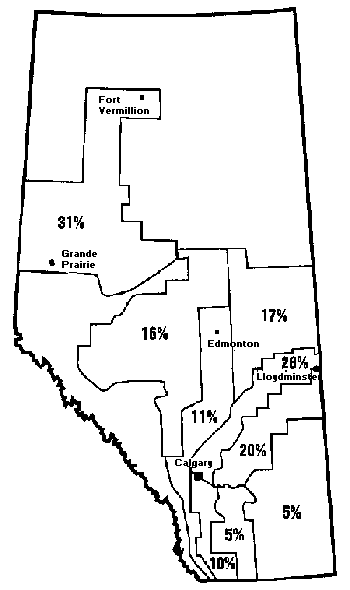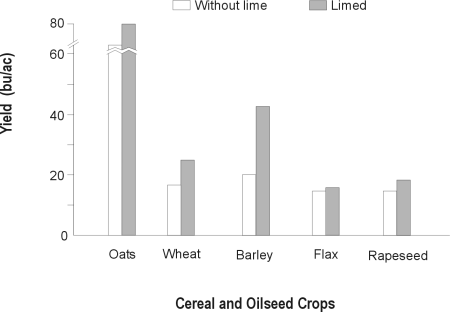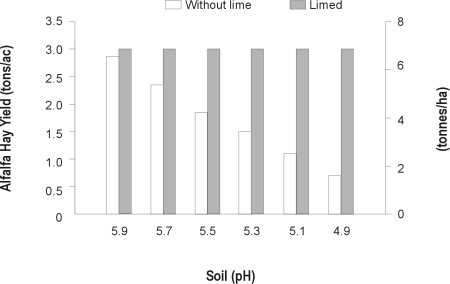| | What is an acid soil? | Where do acid soils occur? | The effect of soil acidity on yield of crops | Management of acid soils
Lime is applied to acid soils to neutralize excess acidity that causes reduced crop yields. The application of lime does not improve saline or solonetzic soil conditions.
There are over 1 million acres of strongly acid and 4.5 million acres of moderately acid soils farmed in Alberta. While many factors, such as the kind of crop, soil type, and climate, influence responses to lime, it can be generally stated that the application of lime should be considered on all strongly acid soils and on many moderately acid soils to improve and maintain productivity. Where liming is an established practice, it is applied to maintain soils in the most suitable pH range for the crops and soils in the area.
What is an acid soil?
Soil acidity is identified by the measurement of soil reaction (pH). The reaction is alkaline when the pH value is above 7.0; neutral at 7.0; and acid below 7.0. In practical terms, soils between pH 6.5 and 7.5 are considered neutral. Soils in the range 5.6 to 6.0 are moderately acid and below 5.5 strongly acid. The poor growth of a sensitive crop such as alfalfa may indicate an acid soil condition. However, a soil test is the only reliable way of determining whether soil is acid or not. A lime requirement test should be used to determine the rate of lime to apply.
Where do acid soils occur?
The distribution of acid soils in Alberta is shown in Figure 1. Acid soils occur most frequently in central Alberta and in the Peace River region. The proportion of acid soil in an area or soil zone can be misleading for the individual farmer. A farm can have neutral soil even though it is in an area of predominantly acid soils. The opposite can also happen. Pockets of acid soils of 2.5 square kilometres or less can occur in a neutral soil area.

Figure 1. Percentage of cultivated acid soils with pH below 6.1 in various areas of Alberta.
Table1. Effects on crops of liming acid soils
| Rating | Soil pH | Direct effects on crops | Indirect effects on crops |
| Slightly acid | 6.1 to 6.5 | No direct effect of liming on most crops. | Liming may improve the physical properties of some medium and fine textured soils (particularly Gray and Dark Gray Wooded soils). |
| Fields with an average pH just above 6.0 may have areas where the pH is below 6.0. Alfalfa and sweet-clover yields will be increased on the more acid areas. | Improved soil structure and reduced crusting will be particularly beneficial for small seeded crops such as canola. |
| Moderately acid | 5.6 to 6.0 | Improved survival and growth of rhizobium bacteria which fix nitrogen in association with alfalfa and sweet clover. | Liming may improve the physical properties of some medium and fine textured soils as indicated above. |
| Yields of alfalfa and sweet clover are increased. | Plant availability of phosphorous fertilizers is improved. |
| . | Increased microbial activity and release of plant nutrients. |
| Small increases in yield of barley occur in the first two or three years following lime applications with larger increases (25-30 per cent) occurring in subsequent years. Yields of wheat and canola will be increased less than barley. Yields of more acid tolerant crops may be increased as a result of indirect effects of lime as outlined above. | . |
| Strongly acid | 5.1 to 5.5 | Increased nitrogen fixation and yield of legumes. | Indirect effects as outlined above for moderately acid soils. |
| Soluble aluminium and manganese are reduced to nontoxic levels. | . |
| Yields of most crops are increased as a result of reduced levels of aluminum and manganese and improved availability of phosphorus and other nutrients. | . |
| Very strongly acid | Less than 5.1 | Direct effects as outlined above for strongly acid soils. | Indirect effects as outlined above for moderately acid soils. |
| Yields of most crops are severely reduced unless the soil is limed. Very strongly acid soils are very infertile. Acid tolerant crops (oats and some grasses) moderately well if adequately fertilized. | . |
The effect of soil acidity on yield of crops
Soil reaction (pH) affects the physical, chemical, and biological properties of soils and crop yields. Crops also vary greatly in their tolerance to the various components of acidity. As a result, the cause of soil acidity damage to crops is often rather complex. The following discussion and Table 1 describe the effect of soil acidity on crops at various pH levels. The effects of acidity on crops can be divided into two general categories - direct effects and indirect effects.
Direct effects
Acid soils often contain soluble forms of aluminum and manganese. As soil acidity increases (pH decreases), soluble aluminum and manganese increase to toxic levels. Aluminum toxicity restricts root growth and phosphorous uptake. Manganese toxicity causes black necrotic spots or streaks on leaves of cereals and chlorosis on leaf margins and cupping of leaves of canola and legumes. Aluminum and manganese toxicity often reduce the yield of crops grown on acid soils. Soil acidity also has a direct effect on the survival and growth of rhizobium bacteria which fix nitrogen in association with legumes. The rhizobium bacteria associated with alfalfa and sweet-clover are especially sensitive to acidity. The application of lime reduces soil acidity (pH increases) which reduces soluble aluminum and manganese to nontoxic levels and creates a suitable environment for rhizobium bacteria.
Indirect effects
The application of lime to acid soils can affect biological, chemical, and physical properties of the soils. The increase in soil pH resulting from the application of lime provides a more favorable environment for soil microbiological activity which increases the rate of release of plant nutrients, particularly nitrogen.
Reduced soil acidity following liming also increases the availability of several other plant nutrients, notably phosphorus. Only about 20 per cent of fertilizer phosphorus is taken up by a crop in the year of application. The remainder is fixed in the soil in various degrees of availability to succeeding crops. On acid soils (pH less 6.0) the fixed phosphorus is retained in less available forms than on slightly acid and neutral soils (pH 6.1 to 7.5). Therefore one of the benefits of liming acid soils is the increased utilization of residual fertilizer phosphorus by crops.
The application of lime can also improve the physical properties of some soils. Reduced soil crusting, improved emergence of small seeded crops such as canola, and reduced power requirements for tillage have been noted as a result of lime applications on Gray and Dark Gray Wooded soils in the Peace River region. (The direct and indirect effects of liming acid soils are outlined further in Table 1.)

Figure 2. Average yield of cereals and crops grown on very strongly acid soils, with and without lime.
Long-term effects
Annual yields of barley in a trial near Tomahawk, Alberta increased by 11.2 bu/ac when 2 tonne per acre of lime was applied to raise the soil pH from 5.3 to 6.5. This yield increase is based on 19 years of data. Soil sampling has shown pH of the limed treatment has decreased to approximately that of the control (no lime) treatment. Yield on the limed treatment continues to be higher than on the control treatment which suggests that in addition to increasing the pH, the application of lime improved soil tilth. Improved tilth results in less soil crusting and improved soil aeration.

Figure 3. Response of alfalfa to lime at various pH levels
Management of acid soils
The first step in the management of acid soils is to identify the extent and severity of the problem. Poor yields of acid sensitive crops may indicate an acid soil condition, but soil tests are the only sure method of identifying an acidity problem. With careful sampling of fields, soil tests can determine the extent and severity of soil acidity, the rate of lime required, and provide an estimate of crop response to lime. An estimate of crop response along with the cost of lime provides a basis for assessing the economics of liming.
Each field that is to be limed should be carefully sampled. Divide a field into areas on the basis of soil type or differences in crop growth and sample each of these areas separately. Some areas of a field may require higher rates than others and some areas may not require any. A lime requirement test should be requested in order to determine the amount of lime required to bring the soil to pH 6.5.
In some cases, growing crops that are more tolerant to acidity is an alternative to liming. But as soils gradually become more acid, the choice of crops becomes very limited. The long-term goal should be to lime soils to a pH value best suited to the crops being grown. After a desired soil pH has been achieved, the amount of lime required to maintain soils in a suitable pH range will depend on fertilizer rates, soil type and cropping practices.
Rate of lime required
The rate of lime required depends on the amount of pH change that is required and the buffering capacity of the soil. Buffering capacity refers to the amount of lime required to change pH a given amount. Sandy soils and soils low in organic matter have low buffering capacities. Clay soils and soils high in organic matter have high buffering capacities. Table 2 is a general guide to the buffering capacity of various soil types.
Table 2. Lime requirement of various soil types
Soil type | Amount of lime to increase
soil pH one unit
(i.e. from 5.0 to 6.0) |
Medium and fine textured Gray
Wooded soils and coarse textured
Dark Brown soils | 1-2 t/ac |
Fine textured Dark Gray and Dark
Gray Wooded soils and medium
textured Dark Brown, Thin Black,
and Black soils | 2-3 t/ac |
Fine textured Black soil, organic,
and peaty soils | 3-4 t/ac |
Quality of agricultural limestone and marl
Calcium carbonate or mixtures of calcium and magnesium carbonate are the most common materials used for liming soils. Calcium and magnesium carbonates occur as limestone rock along the eastern slopes of the Rocky Mountains. Limestone rock must be ground to be effective for neutralizing soil acidity. Marl is an unconsolidated material containing calcium carbonate with varying amounts of silt, clay and organic matter as impurities. Marl is deposited by groundwater discharge and usually occurs in shallow lakes and bogs.
Effective Neutralizing Value (ENV) is a quality index used to express the effectiveness of liming materials for neutralizing soil acidity. This quality index is based on both purity and fineness. Purity is measured as the calcium carbonate equivalent (CCE) which is the theoretical acid neutralizing capacity of a liming material relative to pure calcium carbonate which is 100. The reactivity of limestone depends on how finely it is ground. The per centage of a liming material in various particle size fractions determines the reactivity or efficiency factor of the material. The efficiency factor used for various limestone size fractions is as follows:
Table 3. Efficiency factor of various limestone size fractions
Limestone size fraction | Efficiency factor |
| passing 60 mesh | 100 |
| 30 to 60 mesh | 50 |
| 10 to 30 mesh | 20 |
| retained on 10 mesh | 5 |
Using the efficiency factors shown above, total fineness efficiency is calculated as shown in Table 4. The Effective Neutralizing Value (ENV) is obtained by multiplying the total fineness efficiency by the calcium carbonate equivalent (CCE). Assuming a CCE of 97 per cent, the ENV of the agricultural lime in Table 4 is:
82 x .97 = 80 per cent. If a lime requirement test indicates that 2 tonnes/ ac is needed, the application rate should be:
2 tonnes/ac x 100/80 = 2.5 tonnes/ac
While the coarser mesh sizes (10-60 mesh) are less effective for neutralizing soil acidity, they improve the handling properties of the material. Very fine limestone powder is difficult to handle and apply. On the other hand, if the limestone contains a high proportion of coarse material, higher rates of application are required.
The Effective Neutralizing Value (ENV) of marl can be generally estimated as follows:
- The CCE is usually in the range of 70 to 90 per cent. Impurities consist of silt, clay, and organic matter
- The fineness efficiency can be assumed to be approximately 85 per cent
- The moisture content is usually in the range of 10 to 30 per cent (70 to 90 per cent dry matter)
Table 4. Calculation of total fineness of good quality agricultural lime
Limestone size
fraction | % lime per
size fraction | Efficiency
factor | Fineness
efficiency |
| Passing 60 | 70 | 100 | 70 |
| mesh 30-60 mesh | 20 | 50 | 10 |
| 10-30 mesh | 10 | 20 | 2 |
| Retained on 10 mesh | 0 | 5 | 0 |
| Total Fineness efficiency |  |  | 82 |
For example, if a marl sample has a CCE of 80 per cent, fineness efficiency 85 per cent and dry matter content 85 per cent, the ENV would be: 80 x .85 x .85 = 58 per cent. If the recommended rate of application is 2 tonnes/ac, the amount of this marl that should be applied is:
2 tonnes/ac x 100/58 = 3.4 tonnes/ac
Source: Agdex 534-1 |
|